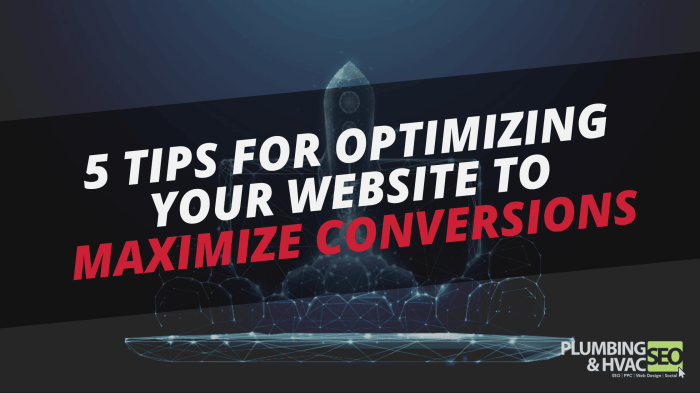Optimizing Website Forms for Conversion sets the stage for boosting your online presence through strategic design and user-friendly practices. Dive into the world of website forms with a twist of modern flair that guarantees to elevate your digital game!
Understanding the purpose of website forms, designing user-friendly layouts, implementing clear call-to-actions, utilizing form analytics, and ensuring mobile responsiveness are just a few clicks away from transforming your website into a conversion powerhouse.
Understanding Website Forms
Website forms are an essential tool for businesses looking to convert visitors into leads or customers. These forms allow users to input their information, such as name, email, and phone number, in exchange for valuable content, discounts, or other offers.
Types of Website Forms
- Landing Page Forms: These are used to capture visitor information on a specific landing page, often offering a free resource or promotion.
- Contact Forms: Found on the “Contact Us” page, these forms allow users to reach out to the business for inquiries or support.
- Subscription Forms: Users can sign up to receive newsletters, updates, or promotions by filling out these forms.
Impact on User Experience
Website forms play a crucial role in user experience as they can either enhance or hinder the overall interaction. For example, a well-designed form with clear instructions and minimal fields can make the process quick and easy for users, leading to higher conversion rates. On the other hand, a form with too many fields, confusing layout, or technical issues can frustrate users and drive them away from completing the submission.
Designing User-Friendly Forms
When it comes to designing user-friendly website forms, there are several best practices to keep in mind. The layout and structure of the form play a crucial role in ensuring a seamless user experience and optimizing conversions. By optimizing form fields and making the entire process as smooth as possible, you can increase the chances of users completing the form and taking the desired action.
Importance of Form Layout and Structure
The layout and structure of a form can significantly impact user interaction and completion rates. Here are some key points to consider:
- Keep the form simple and concise, only asking for essential information to reduce friction.
- Use clear labels and instructions to guide users through the form fields.
- Arrange form fields logically and in a linear order to create a natural flow.
- Implement responsive design to ensure the form is easily accessible on all devices.
Optimizing Form Fields for Better Conversions
Optimizing form fields is crucial for improving conversion rates. Here are some tips to help you optimize your form fields:
- Use autofill and autocomplete features to save users time and effort.
- Minimize the number of required fields to reduce user effort and increase completion rates.
- Utilize inline validation to provide real-time feedback and prevent errors before submission.
- Consider the placement and size of form fields to make it easy for users to input information.
Implementing Clear Call-to-Actions

When it comes to optimizing website forms for conversion, clear call-to-action buttons are crucial. These buttons guide users on what action to take next and can significantly impact the conversion rate of a form.
Significance of Clear and Compelling Call-to-Action Buttons
- Clear call-to-action buttons help users understand what action they need to take next, reducing confusion and improving user experience.
- Compelling call-to-action text can entice users to complete the form by creating a sense of urgency or highlighting the benefits of taking action.
- Well-designed call-to-action buttons can increase conversion rates and ultimately drive more leads or sales for a business.
Tips for Creating Effective Call-to-Action Text
- Use action-oriented language that prompts users to take immediate action, such as “Download Now” or “Get Started”.
- Keep the text concise and clear, avoiding jargon or complex phrases that may confuse users.
- Create a sense of urgency by using phrases like “Limited Time Offer” or “Act Now”.
Placement of Call-to-Action Buttons on Website Forms
- Ensure that the call-to-action button is prominently displayed on the form, making it easy for users to locate and interact with.
- Consider placing the button above the fold to increase visibility and encourage users to take action without scrolling.
- Avoid cluttering the form with too many other elements that may distract from the call-to-action button.
Utilizing Form Analytics: Optimizing Website Forms For Conversion

When it comes to optimizing website forms for maximum conversion rates, form analytics play a crucial role in providing valuable insights into user behavior and preferences. By tracking and analyzing key metrics related to form performance, businesses can make informed decisions to enhance the user experience and drive more conversions.
Key Metrics to Track
- Completion Rate: Measure the percentage of users who successfully submit the form after starting it. A low completion rate may indicate issues with form length, complexity, or user experience.
- Abandonment Rate: Track the number of users who start filling out the form but do not complete it. Identifying the reasons for abandonment can help optimize form design and content.
- Time Spent: Analyze the average time users spend on each form field to identify any bottlenecks or confusing sections that may deter users from completing the form.
- Error Rate: Monitor the frequency of errors users encounter while filling out the form, such as validation errors or incorrect input formats. Addressing common errors can streamline the form submission process.
Analyzing Form Data for Improvement
- Segment User Data: Group users based on their interactions with the form, such as new visitors, returning users, or users who abandoned the form. Analyze each segment’s behavior to tailor form optimization strategies accordingly.
- A/B Testing: Experiment with different form layouts, field arrangements, or call-to-action buttons to determine which variations drive higher conversion rates. Use A/B testing to make data-driven decisions for form optimization.
- Implement Heatmaps: Utilize heatmaps to visualize user interactions with the form and identify areas of high engagement or drop-off. Heatmaps can highlight opportunities for improvement in form design and user flow.
Mobile Responsiveness
When it comes to optimizing website forms for conversion, mobile responsiveness plays a crucial role in ensuring a seamless user experience. With the increasing use of smartphones and tablets, it is essential to make sure that your forms are easy to fill out on mobile devices.
Importance of Mobile-Responsive Forms, Optimizing Website Forms for Conversion
- Mobile traffic: With a significant portion of website traffic coming from mobile devices, having mobile-responsive forms can lead to higher conversion rates.
- User experience: Mobile users expect a smooth and efficient form-filling experience, and non-responsive forms can deter them from completing the process.
- benefits: Google prioritizes mobile-friendly websites in search results, so having mobile-responsive forms can also improve your site’s visibility.
Tips for Optimizing Forms for Mobile Users
- Keep it simple: Limit the number of form fields and make sure they are easy to tap on a touchscreen.
- Use autofill: Enable autofill options for common fields like name, email, and phone number to save users time.
- Big buttons: Design clear and prominent call-to-action buttons that are easy to locate and tap on mobile screens.
Ensuring a Seamless Form-Filling Experience on Mobile Devices
- Testing: Regularly test your forms on different mobile devices to ensure they display correctly and are easy to use.
- Optimize load times: Reduce the size of images and scripts to improve loading speed on mobile devices.
- Responsive design: Implement responsive design principles to ensure that your forms adjust to different screen sizes and orientations.












